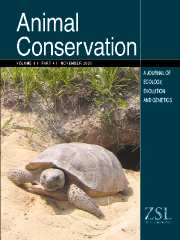Crossref Citations
This article has been cited by the following publications. This list is generated based on data provided by
Crossref.
2005.
Culling Livestock Killers As a Conservation Strategy.
Conservation in Practice,
Vol. 6,
Issue. 3,
p.
140.
Lindsey, Peter A.
du Toit, Johan T.
and
Mills, M.G.L.
2005.
Attitudes of ranchers towards African wild dogs Lycaon pictus: Conservation implications on private land.
Biological Conservation,
Vol. 125,
Issue. 1,
p.
113.
SHIVIK, JOHN A.
2006.
Tools for the Edge: What's New for Conserving Carnivores.
BioScience,
Vol. 56,
Issue. 3,
p.
253.
Young, Julie K.
and
Shivik, John A.
2006.
What carnivore biologists can learn from bugs, birds, and beavers: a review of spatial theories.
Canadian Journal of Zoology,
Vol. 84,
Issue. 12,
p.
1703.
Woodroffe, Rosie
Frank, Laurence G.
Lindsey, Peter A.
ole Ranah, Symon M. K.
and
Romañach, Stephanie
2006.
Vertebrate Conservation and Biodiversity.
Vol. 5,
Issue. ,
p.
419.
Kolowski, J.M.
and
Holekamp, K.E.
2006.
Spatial, temporal, and physical characteristics of livestock depredations by large carnivores along a Kenyan reserve border.
Biological Conservation,
Vol. 128,
Issue. 4,
p.
529.
WOODROFFE, ROSIE
DONNELLY, CHRISTL A.
COX, D. R.
BOURNE, F. JOHN
CHEESEMAN, C. L.
DELAHAY, R. J.
GETTINBY, GEORGE
MCINERNEY, JOHN P.
and
MORRISON, W. IVAN
2006.
Effects of culling on badger Meles meles spatial organization: implications for the control of bovine tuberculosis.
Journal of Applied Ecology,
Vol. 43,
Issue. 1,
p.
1.
Woodroffe, Rosie
Frank, Laurence G.
Lindsey, Peter A.
ole Ranah, Symon M. K.
and
Romañach, Stephanie
2007.
Livestock husbandry as a tool for carnivore conservation in Africa’s community rangelands: a case–control study.
Biodiversity and Conservation,
Vol. 16,
Issue. 4,
p.
1245.
Georgiadis, Nicholas J.
Ihwagi, Festus
Olwero, J.G. Nasser
and
Romañach, Stephanie S.
2007.
Savanna herbivore dynamics in a livestock-dominated landscape. II: Ecological, conservation, and management implications of predator restoration.
Biological Conservation,
Vol. 137,
Issue. 3,
p.
473.
Holmern, Tomas
Nyahongo, Julius
and
Røskaft, Eivin
2007.
Livestock loss caused by predators outside the Serengeti National Park, Tanzania.
Biological Conservation,
Vol. 135,
Issue. 4,
p.
518.
Hayward, Matt W.
Adendorff, John
Moolman, Lucius
Hayward, Gina J.
and
Kerley, Graham I. H.
2007.
The successful reintroduction of leopard Panthera pardus to the Addo Elephant National Park.
African Journal of Ecology,
Vol. 45,
Issue. 1,
p.
103.
Loveridge, A.J.
Searle, A.W.
Murindagomo, F.
and
Macdonald, D.W.
2007.
The impact of sport-hunting on the population dynamics of an African lion population in a protected area.
Biological Conservation,
Vol. 134,
Issue. 4,
p.
548.
SCHIESS‐MEIER, MONIKA
RAMSAUER, SANDRA
GABANAPELO, TEFO
and
KÖNIG, BARBARA
2007.
Livestock Predation—Insights From Problem Animal Control Registers in Botswana.
The Journal of Wildlife Management,
Vol. 71,
Issue. 4,
p.
1267.
Woodroffe, Rosie
Lindsey, Peter A.
Romañach, Stephanie S.
and
Ranah, Symon M. K. ole
2007.
African Wild Dogs (Lycaon pictus) Can Subsist on Small Prey: Implications for Conservation.
Journal of Mammalogy,
Vol. 88,
Issue. 1,
p.
181.
Hays, G.C.
Bradshaw, C.J.A.
James, M.C.
Lovell, P.
and
Sims, D.W.
2007.
Why do Argos satellite tags deployed on marine animals stop transmitting?.
Journal of Experimental Marine Biology and Ecology,
Vol. 349,
Issue. 1,
p.
52.
Lagendijk, D. D. Georgette
and
Gusset, Markus
2008.
Human–Carnivore Coexistence on Communal Land Bordering the Greater Kruger Area, South Africa.
Environmental Management,
Vol. 42,
Issue. 6,
p.
971.
Treves, Adrian
2009.
Hunting for large carnivore conservation.
Journal of Applied Ecology,
Vol. 46,
Issue. 6,
p.
1350.
Inskip, Chloe
and
Zimmermann, Alexandra
2009.
Human-felid conflict: a review of patterns and priorities worldwide.
Oryx,
Vol. 43,
Issue. 01,
p.
18.
TREVES, ADRIAN
WALLACE, R. B.
and
WHITE, S.
2009.
Participatory Planning of Interventions to Mitigate Human–Wildlife Conflicts.
Conservation Biology,
Vol. 23,
Issue. 6,
p.
1577.
Hazzah, Leela
Borgerhoff Mulder, Monique
and
Frank, Laurence
2009.
Lions and Warriors: Social factors underlying declining African lion populations and the effect of incentive-based management in Kenya.
Biological Conservation,
Vol. 142,
Issue. 11,
p.
2428.


